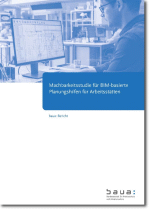- Project number: F 2471
- Institution: Federal Institute for Occupational Safety and Health (BAuA) / GWT-TUD GmbH
- Status: Completed Project
Description:
In Germany, it is the Workplaces Ordinance (Arbeitsstättenverordnung, ArbStättV) and the Technical Rules for Workplaces (Technische Regeln für Arbeitsstätten, ASR), in particular, that have to be taken into account in order to ensure working conditions are designed safely and healthily during the planning, construction, and fitting-out of workplaces. In practice, errors and misunderstandings sometimes arise when organisations seek to comply with the relevant requirements. Building Information Modelling (BIM) is a generic planning methodology deployed in the construction industry. BIM allows data from various technical fields, which may be generated by different participants in the planning process, to be collated in a single data model. This means that, as well as holding out significant opportunities to draw together the aspects of construction planning processes specific to particular disciplines, BIM also allows occupational safety and health concerns to be factored in. The implications were investigated in this feasibility study with analyses, surveys, and demonstration scenarios.
The study describes three approaches to BIM-based planning tools that can be implemented in principle:
- the provision of information to participants prior to the planning process (information platform),
- assitance systems that deliver support directly during the planning process, and
- inspections and/or checks following the planning process or individual planning stages.
The basis for all such planning tools is the analysis, interpretation, and digital representation of workplace law. It is necessary for the substantive content of the law to be available as data that can be numerically processed for software applications. The quality and validity of these data must be guaranteed. With the component-oriented representation of assets, BIM offers a concept for the practical, structured analysis of workplace law. Apart from minimum requirements, planning tools should also convey broader design recommendations. The practicality of the component-oriented analysis of workplace law was confirmed and potential ways of implementing it in planning tools explored using the example of the object category “door”. The introduction of BIM into practice is currently opening up opportunities to coordinate and help configure the interfaces with occupational safety and health provisions, including database structures and additional attributes within the component classifications used in BIM applications.
The feasibility study shows it is possible for occupational safety and health requirements, such as those imposed by workplace law, to be analysed, communicated, and integrated into planning processes on the basis of BIM. These approaches will have to be investigated further with projects that build on the study’s findings, and specified in concrete terms with examples of how they can be implemented.

